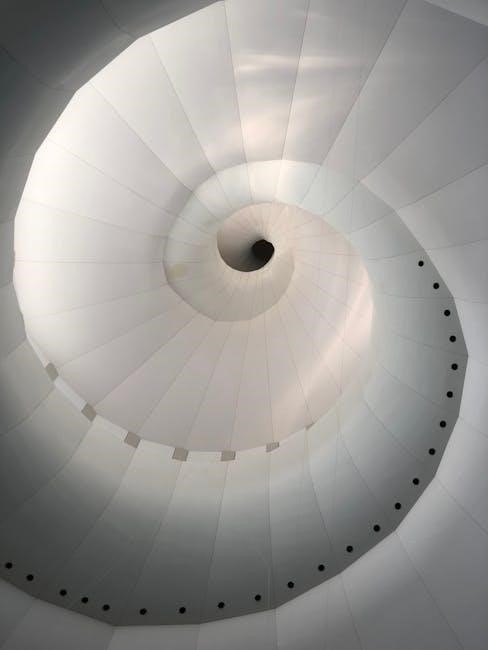Liebestraum No. 3‚ composed by Franz Liszt‚ is a renowned piano piece from his Liebesträume set‚ originally a song transcribed for solo piano‚ expressing deep love and longing.
1.1 Overview of the Composition
Liebestraum No. 3‚ part of Franz Liszt’s Liebesträume set‚ is a solo piano piece originally based on a song for voice and piano. It is known for its emotional depth‚ technical challenges‚ and expressive qualities. The composition balances virtuosic elements with lyrical melodies‚ making it a beloved and iconic work in the Romantic piano repertoire‚ widely available in PDF sheet music formats for pianists of various skill levels.
1.2 Historical Context and Significance
Composed in 1850‚ Liebestraum No. 3 is one of three pieces in Franz Liszt’s Liebesträume‚ a set of solo piano works based on songs about love. The piece‚ originally written with lyrics by Ferdinand Freiligrath‚ reflects Liszt’s romantic ideals and technical innovation. Its enduring popularity and emotional power have made it a cornerstone of Romantic piano literature‚ with PDF sheet music widely accessible to pianists today.
Background and Inspiration
Liebestraum No. 3 originated as a song with lyrics by Ferdinand Freiligrath‚ exploring themes of unconditional love. Liszt’s transcription captures the emotional depth‚ reflecting his romantic inspiration.
2.1 The Original Song and Its Lyrics
The original song‚ O lieb‚ so lang du lieben kannst‚ features lyrics by Ferdinand Freiligrath‚ emphasizing the virtues of unconditional love. Composed as a vocal piece with piano accompaniment‚ it conveys profound emotional depth and poetic beauty‚ later inspiring Liszt’s celebrated transcription for solo piano.
2.2 Liszt’s Transcription for Solo Piano
Franz Liszt’s transcription of Liebestraum No. 3 transforms the original song into a masterful solo piano piece‚ retaining the emotional intensity while showcasing technical brilliance. The transcription captures the longing and passion of Freiligrath’s poem‚ translating vocal melodies into intricate piano passages. Its complexity and beauty have made it a cornerstone of Romantic piano repertoire‚ admired for both its technical demands and expressive depth.

Musical Structure and Characteristics
Liebestraum No. 3 in A-flat Major features a lyrical‚ dreamlike quality‚ with sections marked Poco Allegro and Dolce Cantando‚ blending technical brilliance with emotional depth and romantic expression.
3.1 Poco Allegro‚ con affetto
The piece begins with a Poco Allegro‚ con affetto marking‚ characterized by a flowing‚ lyrical melody in the right hand‚ accompanied by arpeggiated chords in the left. This section establishes the dreamlike‚ romantic atmosphere‚ with expressive dynamics and rubato‚ allowing for interpretative freedom. The A-flat major tonality enhances the emotional depth‚ creating a sense of longing and tenderness‚ while the technical demands showcase Liszt’s mastery of pianistic writing.
3.2 Dolce Cantando
The Dolce Cantando section introduces a gentle‚ singing melody‚ marked by legato phrasing and nuanced expression. This lyrical passage contrasts with the earlier Poco Allegro‚ emphasizing tender‚ heartfelt emotions. The right hand carries the melody with delicate grace‚ supported by soft‚ undulating arpeggios in the left‚ creating a serene and intimate atmosphere that deepens the piece’s romantic essence and technical brilliance‚ typical of Liszt’s compositional style.
3.3 Key Signature and Technical Challenges
Liebestraum No. 3 is written in A-flat major‚ a key that enhances its lyrical and expressive qualities. The piece presents technical challenges‚ including intricate arpeggios‚ fast scales‚ and complex fingerings. Pianists must master dynamic contrasts‚ nuanced pedaling‚ and dexterity to maintain clarity and emotional depth‚ making it a true test of virtuosic skill and musical interpretation.

Liebestraum No. 3 in A-flat Major
Liebestraum No. 3 in A-flat Major is the most celebrated piece from Liszt’s Liebesträume set‚ known for its breathtaking emotional depth and lyrical beauty in the romantic era.
4.1 The A-flat Major Version
The A-flat Major version of Liebestraum No. 3 is the most celebrated arrangement‚ renowned for its lush harmonies and expressive melody. It captures the essence of romanticism‚ with a dreamy‚ lyrical quality that resonates deeply with listeners. This version‚ part of Liszt’s Liebesträume set‚ remains a cornerstone of piano repertoire‚ admired for its technical brilliance and emotional profundity.
4.2 Emotional Depth and Expression
Liebestraum No. 3 in A-flat Major conveys profound emotional depth‚ evoking themes of love and longing. Its melancholic yet passionate melody‚ accompanied by intricate arpeggios‚ creates a sense of yearning. The piece’s expressive dynamics and rubato allow pianists to convey intense emotion‚ making it a favorite for both performers and audiences seeking a deeply moving musical experience.
PDF Versions and Sheet Music Availability
Liebestraum No. 3 is widely available in PDF format‚ with versions ranging from 1 to 6 pages. Free scores can be downloaded from platforms like Free-Scores and PianoCoda.
5.1 Free Sheet Music Sources
Free sheet music for Liebestraum No. 3 is available on platforms like PianoCoda‚ Free-Scores‚ and Mfiles. These sites offer PDF downloads‚ including 1‚ 2‚ 4‚ and 6-page versions‚ catering to different preferences. Additionally‚ arrangements for solo piano and other instruments can be found‚ ensuring accessibility for musicians of all levels.
5.2 Different Page Versions (1‚ 2‚ 4‚ 6 Pages)
Liebestraum No. 3 is available in various page versions‚ including 1‚ 2‚ 4‚ and 6 pages. These versions cater to different preferences‚ offering both concise and detailed layouts. The 1-page version is ideal for quick reference‚ while the 6-page provides a more expansive view. All versions are accessible on platforms like Free-Scores and PianoCoda‚ ensuring versatility for pianists of all levels.
5.3 Sibelius File and Other Arrangements
The Sibelius file of Liebestraum No. 3 is available for arrangers and performers‚ enabling customization and deeper interaction with the score. Additionally‚ arrangements like the English Horn and Piano version by Bernard Dewagtere expand its reach. These adaptations‚ along with MIDI files‚ are accessible on platforms like Free-Scores‚ offering diverse interpretations and enhancing the piece’s versatility for musicians worldwide.

Performance and Interpretation
Liebestraum No. 3 demands exceptional technical skill and emotional depth‚ making it a showcase for virtuosic pianists. Its interpretation requires balancing delicate nuances with passionate expression‚ captivating audiences worldwide.
6.1 Virtuosic Elements and Pianistic Demands
Liebestraum No. 3 presents intricate finger dexterity‚ arpeggios‚ and dynamic contrasts‚ challenging pianists. Its technical demands include rapid passages and nuanced pedaling‚ requiring mastery for an expressive performance that captures the piece’s emotional essence and Liszt’s compositional brilliance. These elements make it a true test of pianistic skill and artistry.
6.2 Famous Performances and Recordings
Liebestraum No. 3 has been performed by renowned pianists like Lang Lang and Maurizio Pollini‚ showcasing its enduring appeal. Arthur Rubinstein’s recording is particularly celebrated for its emotional depth. Additionally‚ unconventional performances‚ such as a rendition for English horn and piano‚ highlight the piece’s versatility. Its beauty continues to captivate audiences across diverse interpretations and settings‚ including a unique performance by seals at SEALIFE in Mooloolaba.

Simplified Versions and Adaptations
Simplified versions of Liebestraum No. 3 cater to amateur musicians‚ offering accessible arrangements without losing the piece’s emotional essence. Instrumental adaptations further showcase its versatility and enduring appeal.
7.1 Arrangements for Amateur Musicians
Arrangements for amateur musicians simplify Liebestraum No. 3‚ making it accessible while preserving its emotional depth. Free sheet music and MIDI files are available on platforms like PianoCoda.com and Free-scores‚ offering various difficulty levels. These adaptations enable learners to grasp the piece’s essence without overwhelming technical demands‚ fostering a deeper connection to Liszt’s timeless composition.
7.2 Instrumental Adaptations (e.g.‚ English Horn and Piano)
Liebestraum No. 3 has been adapted for various instruments‚ such as the English Horn and Piano‚ offering fresh interpretations. Arranged by Bernard Dewagtere‚ this version is available as a 3-page PDF with 2 MP3 play-along tracks‚ ideal for intermediate players. Such adaptations broaden the piece’s accessibility‚ allowing musicians to explore its beauty across different instrumental combinations while maintaining its emotional core.

Liebestraum No. 3 in Popular Culture
Liebestraum No. 3 has been featured in films‚ commercials‚ and media‚ enhancing emotional scenes. A notable performance occurred at SEALIFE in Mooloolaba‚ Queensland‚ where seals enjoyed the piece on Valentine’s Day‚ illustrating its universal appeal.
8.1 Use in Films‚ Commercials‚ and Media
Liebestraum No. 3 often enhances emotional scenes in films and commercials‚ its melodic beauty captivating audiences. Its performance at SEALIFE in Mooloolaba for Valentines Day showcased its charm‚ demonstrating its versatility and enduring appeal.
8.2 Performances in Unconventional Settings
Liebestraum No. 3 has been performed in unique settings‚ such as SEALIFE in Mooloolaba‚ where seals enjoyed a live rendition on Valentine’s Day. Such performances highlight the piece’s universal appeal‚ making it accessible to diverse audiences beyond traditional concert halls.
Educational Resources and Tutorials
Educational resources for Liebestraum No. 3 include MIDI files‚ play-along versions‚ and simplified sheet music‚ aiding students with structured tutorials and practice tools effectively.
9.1 Sheet Music for Beginners
Beginners can access simplified sheet music for Liebestraum No. 3 in PDF format‚ offering a more approachable version of the piece. These adaptations retain the emotional essence while reducing technical complexity‚ making it easier for amateur pianists to learn and perform. Many websites provide free downloads‚ ensuring accessibility for musicians at various skill levels.
9.2 MIDI Files and Play-along Versions
MIDI files of Liebestraum No. 3 are widely available‚ allowing pianists to practice along with digital accompaniments. These files provide tempo control and expressive dynamics‚ aiding in mastering the piece. Additionally‚ play-along versions enable musicians to rehearse with virtual orchestras or ensemble settings‚ enhancing their interpretative skills and emotional expression.
Such resources are particularly useful for educational purposes‚ helping learners internalize the music’s structure and phrasing while maintaining artistic integrity. Many websites offer free MIDI downloads‚ making these tools accessible to pianists of all levels.
The Complete Liebesträume Set
The Liebesträume set comprises three pieces‚ originally songs transcribed for piano‚ published in 1850‚ capturing deep emotional longing and romantic devotion‚ with No. 3 being the most celebrated.
10.1 Overview of the Three Pieces
The Liebesträume set includes three pieces‚ originally songs for voice and piano‚ transcribed for solo piano. Each piece reflects romantic themes‚ with No. 3‚ in A-flat Major‚ being the most famous‚ known for its emotional depth and technical complexity‚ capturing the essence of love and longing in Liszt’s signature Romantic style.
10.2 Comparisons with Liebestraum No. 3
Liebestraum No. 3 stands out for its technical demands and emotional intensity compared to the other two pieces. While all three share romantic themes‚ No. 3 is notable for its complex arpeggios and nuanced dynamics‚ making it a showcase for virtuosic pianism and expressive interpretation‚ surpassing its companions in popularity and performance frequency.

Franz Liszt’s Legacy
Franz Liszt’s legacy endures as a pioneer of Romantic piano music‚ with works like Liebestraum No. 3 exemplifying his technical brilliance and emotional depth‚ influencing generations of musicians.
11.1 His Impact on Romantic Piano Music
Franz Liszt revolutionized Romantic piano music with his technical mastery and emotional depth. His compositions‚ including Liebestraum No. 3‚ set new standards for virtuosity and expressive interpretation‚ influencing generations of pianists and composers. By blending poetic lyricism with intricate techniques‚ Liszt elevated the piano’s role in Romantic music‚ creating works that remain central to the repertoire.
11.2 Liebestraum No. 3 as a Representative Work
Liebestraum No. 3 exemplifies Liszt’s artistic genius‚ blending lyrical beauty with technical brilliance. As a quintessential Romantic piece‚ it showcases his ability to transform emotional depth into music‚ making it a cornerstone of his legacy and a defining work of the era‚ reflecting both his compositional innovation and profound expressiveness.
Digital Sheet Music Platforms
Digital platforms like Free-Scores and PianoCoda offer Liebestraum No. 3 in PDF and MIDI formats‚ providing access to various arrangements‚ including simplified versions for amateur musicians and professionals alike.
12.1 Free-Scores and Other Websites
Websites like Free-Scores and PianoCoda offer a variety of Liebestraum No. 3 PDF versions‚ including 1‚ 2‚ 4‚ and 6-page formats‚ along with Sibelius files for deeper customization. These platforms provide access to both original and simplified arrangements‚ catering to amateur and professional musicians. Additionally‚ sheet music in different key signatures‚ such as A-flat major‚ is available for download‚ ensuring versatility for diverse musical needs.
12.2 Quality and Variations in Available PDFs
Liebestraum No. 3 PDFs are available in various formats and qualities‚ catering to different preferences. Versions range from 1 to 6 pages‚ offering flexibility for performers. Sibelius files are also accessible for deeper customization. Additionally‚ arrangements for amateur musicians and instrumental adaptations‚ such as English horn and piano‚ provide diverse options. These variations ensure accessibility and adaptability for musicians of all skill levels and interests.

The Emotional and Technical Balance
Liebestraum No. 3 masterfully blends emotional depth with technical complexity. It captures profound longing and love while challenging pianists with intricate passages‚ requiring precise balance between expression and skill.
13.1 Expressing Longing and Love
Liebestraum No. 3 is a renowned piano piece that expresses deep love and longing. Originally a song‚ it captures the intensity of romantic emotion‚ evoking a profound connection between performer and listener through its lyrical melodies and expressive nuances‚ making it a timeless favorite in classical music repertoire.
13.2 Mastering the Technical Demands
Mastery of Liebestraum No. 3 requires precise technical skill and artistic sensitivity. The piece demands refined finger dexterity‚ nuanced pedaling‚ and expressive phrasing. Pianists must balance intricate arpeggios and chord progressions with delicate melodic lines‚ ensuring both technical accuracy and emotional depth to convey the work’s romantic essence effectively.

Liebestraum No. 3 in Music Education
Liebestraum No. 3 is a valuable educational tool‚ offering insights into Romantic-era techniques. Its PDF sheet music and MIDI files aid students in studying and practicing the piece effectively.
14.1 Teaching the Piece to Students
Teaching Liebestraum No. 3 involves breaking it into manageable sections‚ focusing on technical and emotional aspects. Educators often use simplified versions for beginners‚ gradually introducing complexity. MIDI files and play-along tools enhance practice‚ while detailed sheet music analysis aids in understanding Liszt’s expressive intent. This approach fosters both technical mastery and emotional connection‚ essential for interpreting Romantic-era music effectively.
14.2 Analyzing the Score for Educational Purposes
Analyzing the score of Liebestraum No. 3 provides insights into Liszt’s mastery of phrasing‚ dynamics‚ and emotional depth. Educators often focus on harmonic progressions‚ arpeggio patterns‚ and expressive markings. MIDI files and play-along versions help students internalize rhythms and tempos. Detailed PDF scores enable close examination of articulations‚ fingerings‚ and pedaling techniques‚ fostering a deeper understanding of Romantic-era performance practices and technical demands.
Liebestraum No. 3 remains a timeless masterpiece‚ blending emotional depth with technical mastery. Exploring Liszt’s other works reveals his genius in Romantic piano music. PDFs available.
15.1 Final Thoughts on Liebestraum No. 3
Liebestraum No. 3 is a profound expression of love and longing‚ showcasing Liszt’s mastery of emotion and technique. Its timeless beauty resonates with pianists and audiences alike‚ making it a cornerstone of Romantic piano repertoire. Available in various PDF versions‚ it remains accessible for both professionals and amateurs‚ ensuring its enduring legacy in classical music.
15.2 Encouragement to Explore More of Liszt’s Works
Liebestraum No. 3 serves as a gateway to Liszt’s vast and intricate oeuvre. Exploring his other masterpieces‚ such as La Campanella or Hungarian Rhapsodies‚ reveals his innovative genius and emotional depth. Delving into his compositions offers a rich journey through Romantic piano music‚ with sheet music readily available on platforms like Free-Scores and PianoCoda‚ ensuring his legacy endures for future generations to cherish and study.




Leave a Reply
You must be logged in to post a comment.